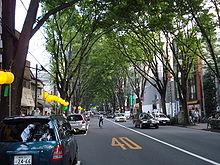- Asagaya
-
Asagaya (阿佐ヶ谷), a suburb of Tokyo located in the Suginami ward west of Shinjuku. Main access to Asagaya is via the Chūō-Sōbu Line, 12 minutes out from Shinjuku station.
Contents
Geography
At present the Asagaya area is divided latitudinally into North (阿佐ヶ谷北, Asagaya-kita) and South (阿佐谷南, Asagaya-Minami) by the Chūō-Sōbu Line. Boundaries for this area are roughly the same as whose that existed for Asagaya Village (阿佐ヶ谷村 Asagaya-mura) dating back to the Edo Period. Longitudinally, the Japanese Zelkova serrata tree-lined boulevard, Nakasugi-dōri (中杉通り), divides Asagaya, running from Ome-kaido in the south to Waseda-dōri in the north. From around the Taishō period people began moving from the Yamanote area (central Tokyo) into the suburbs including Asagaya. At present, the area around the station is considered upper-level Tokyo suburban housing due to its space, greenery, convenience to central Tokyo as well as its numerous Shōtengai, the largest of which originates from the South exit of JR Asagaya Station.
Asagaya is accessible by train, subway and bus. The ward office is located directly above the Asagaya Minami Maru-no-uchi line station.
Transportation
- 35°42′18″N 139°38′08″E / 35.704862°N 139.635533°E JR East Asagaya Station
- 35°41′58″N 139°38′08″E / 35.699438°N 139.635587°E Tokyō Metro Minami-Asagaya Station
History
The origin of the area name "Asagaya" comes from the combination of two words, the adjective "asai" meaning "shallow"[1] and the geographical noun "Yachi" (谷地) meaning "marsh" or low wetlands. In 1921 a stop was created on the Sōbū streetcar line running on Ome-kaido from Shinjuku to Ogikubo which would later become the Tōden Suginami (都電杉並線) streetcar line, then the present subway Marunouchi line. Service on the Tōden Suginami streetcar ended in 1961. Asagaya Station was built and added to the Kōbu railway line (built 1884; Kōbu-tetsudo (甲武鉄道) in 1924[2], which would later become the Chūō Main Line.
After the exodus from central Tokyo following the Kantō Earthquake of 1923, Asagaya became the home to a literature community beginning with Ibuse Masuji, and eventually including Yosano Akiko, Dazai Osamu, Aoyagi Mizuho, Iba Harube, Miyoshi Tatsuji, Hino Ashihei, and Tokugawa Musei. Because of this history Asagaya is also known as "Literary Town Asagaya".
Entertainment
Theater, film, and music
Asagaya is home to three theater spaces, Hitsuji-za[3], Theater Shine [4], and Zamuza [5] located about the revival movie house Laputa[6] which specializes in 1950–1970s Japanese film.
Along the bar streets that run to the west of the JR Asagaya Station on the north and south sides there are a number of tiny venues for music, mostly Jazz and folk oriented. Also a number of bars specializing in Jazz, Blues, and British Rock pepper the western bar area.
Shopping
The covered shopping street (shōtengai) Pearl Center, located on the south side of JR Asagaya station, is the largest in the area, though, smaller uncovered shōtengai also run to the north of the station. While Koenji to the east is known for its used clothing stores, most of the goods available are oriented toward household needs, though on the north side a number of used book and manga stores also do business.
Eating and drinking
On the lively street, Star Road (スターロード) originating from the northeast side of the JR Asagaya station, there are a number of tiny, intimate eateries, however while some places are renowned for their food, the size and number of these dens makes for an adventure.
On the southwest side of the station on Kawabata Street (かわばた通り), a number of bars and yakitori places abound, and other grilled delights abound.
Festivals
Asagaya has two large festivals each year. The Tanabata (七夕祭り)[7] during the first week of July is held everyday for a week during the first week of July. The Tanabata festival is known for its assortment of hanging papier-mâché characters that adorn the Pearl Road.
Asagaya is also known for its jazz festival, Asagaya Jazz Streets,[8] held over the last weekend in October. This jazz festival is one of the largest in the city with musicians playing an assortment of venues.
Asagaya in film
Asagaya appears in the films Ringu, Ringu 2, Death Note, and Yellow Tears.
References
- ^ The kanji for the adjective "Asai" (浅い) differs from the area name "Asa" (阿佐) for aesthetic reasons)
- ^ Japanese Wikipedia page: http://ja.wikipedia.org/wiki/%E9%98%BF%E4%BD%90%E3%83%B6%E8%B0%B7
- ^ 小劇場 ひつじ座
- ^ ようこそシャインへ
- ^ Samsa Asagaya
- ^ Laputa ASAGAYA
- ^ [夏祭り2006 阿佐谷七夕まつり]
- ^ Asagaya Jazz Streets (Japanese)
External links
- Asagaya Jazz Streets (Japanese)
- Asagaya Navigator (Japanese)
Neighborhoods of Tokyo Akasaka · Akihabara · Aoyama · Asagaya · Asakusa · Asakusabashi · Azabu · Daikanyama · Den-en-chōfu · Ebisu · Futako Tamagawa · Ginza · Gotanda · Hamamatsuchō · Harajuku · Hibiya · Hongō · Ichigaya · Iidabashi · Ikebukuro · Iwamotochō · Jiyūgaoka · Jinbōchō · Jūjō · Kabukichō · Kagurazaka · Kajichō · Kamata · Kanda · Kasumigaseki · Kichijōji · Koishikawa · Kugayama · Kyōbashi · Kōenji · Kōjimachi · Marunouchi · Mita · Meguro-Mita · Nagatachō · Nihonbashi · Nishi-Shinjuku · Nishikichō · Ochanomizu · Odaiba · Ogawamachi · Ōizumigakuenchō · Ōmori · Omotesandō · Ōtemachi · Roppongi · Ryōgoku · San'ya · Sendagaya · Shiba · Shibaura · Shibuya · Shimokitazawa · Shinbashi · Shinjuku · Shinjuku ni-chōme · Shiodome · Shirokane · Shirokanedai · Sudachō · Sugamo · Surugadai · Takadanobaba · Takanawa · Tamachi · Tateishi · Tsukiji · Tsukishima · Uchi-Kanda · Uchisaiwaichō · Ueno · Wakasu · Yaesu · Yayoi · Yōga · Yotsuya · Yoyogi · Yūrakuchō
Categories:- Neighborhoods of Tokyo
Wikimedia Foundation. 2010.

